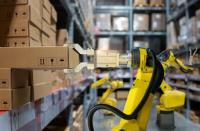 Add My Company
Add My Company
Sign In

Over the last several decades, robotics has become a vital part of warehousing management and is only growing in importance. While its role used to be confined to simple tasks as the warehousing robotics has become more sophisticated, so has its role in warehousing and fulfilment.
In fact, today it is difficult to find any major warehousing operation that does not employ several layers of robotics. Here is why…
What are Warehouse Robotics?
To understand how warehouse robotics can help an organization, it is important to understand what the term means. “Warehousing robotics” is very broad and can apply to just about every aspect of a supply chain that has direct contact with a warehousing operation.
Specifically, warehouse robotics applies to automated systems, robots and software used to streamline and improve warehousing operations. This can include but is not limited to:
Pallet Management
Inventory Management and Fulfillment
Inventory Systems Management
Back End Fulfillment
Item Scanning and Documentation
Here are areas that robotics can help the average warehouse improve its operations and both customer and employee satisfaction.
Safety
There are many ways warehousing employees can get hurt. The three most common are slips and falls, repetitive task injuries and items falling on people. In addition, many employees can get injured by lifting improperly or more than they can handle or having parts of their body crushed in shelving or by machinery.
A warehouse is certainly not the most dangerous place to work, but there are literally dozens of ways an employee can run into trouble daily.
A robot not only can do a job more safely than a human but it will also not fatigue. That means injuries caused by carelessness due to tiredness will be dramatically lowered.
Efficiency
The most efficient human employee is not as methodical or accurate as a tuned robotic system. A robot can work faster and more accurately than a human and automated systems cut out the most error-prone facet of the warehouse experience: The human employee.
That means orders get filled quicker, with fewer mistakes. Customers get billed correctly. Stock is always professionally managed. Overall, staff, management and customers are happier with the product.
Quality Assurance
This ties in with efficiency. Barring human operator or input error, a robot can work faster and more accurately, which means mistakes on orders will be reduced if not eliminated. In fact, it is safe to say the only aspect of a robotic system that will make a mistake is the human element because a robotic system only does what it is told to do.
That means once warehouse robotics are tuned, fulfilment can be streamlined to be quicker and more accurate than a human staff can manage consistently. Speed of delivery can be improved. Customers get what they ordered, on time, which means they are happy with the service provided.
Labour Issues
Warehouse management generally has high attrition among employees. Automated systems address many of the issues human employees bring to the table.
A robot shows up to work does its job, does not complain and sticks around. It does not have labour complaints and provided it is maintained properly, will always perform as expected.
Each of the benefits robotics brings to warehousing results in one thing: Happier customers through the automated organization. Warehousing robotics is a must for any business looking to streamline operations and improve the overall customer experience.
Contact us today if you have any questions about our robot system products.
For more information on How can warehouse robotics improve warehousing? talk to Robot System Products
Enquire Now
List your company on FindTheNeedle.
